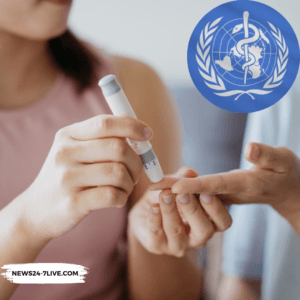Latest News about diabetes reveals that over 800 million adults worldwide are living with diabetes. A rise in global diabetes prevalence has seen rates in adults jump from 7% in 1990 to 14% in 2022.

The total number of adults with diabetes globally has more than quadrupled since 1990 surpassing 800 million by 2022.
Diabetes rates in adults have doubled from approximately 7% in 1990 to around 14% in 2022. Low and middle-income countries saw the largest increase in diabetes cases, as opposed to many high-income countries where rates remained stable or even declined.
Four countries bear over half of the global diabetes burden, India, China, the United States and Pakistan. In 2022, 212 million adults with diabetes were in India alone followed by 148 million in China, 42 million in the US and 36 million in Pakistan.
Other nations with high diabetes rates include Indonesia with 25 million and Brazil with 22 million.
Obesity and poor diets are drivers of the rising latest news about diabetes with increased rates of type 2 diabetes in areas where unhealthy diets and sedentary lifestyles are prevalent.
While type 1 diabetes results from an autoimmune disorder, type 2 diabetes, which accounts for over 95% of global cases and it is largely preventable through healthy lifestyle changes.
Countries with low obesity rates such as those in Western Europe and parts of East Africa have managed to keep diabetes rates relatively low.
445 million adults over 30 with diabetes were untreated in 2022, tripling the untreated population from 1990. High-income countries like Belgium have high treatment rates with 86% of women and 77% of men receiving medication.
Latest news about diabetes shows that in low-income countries, people with diabetes tend to be younger. Younger populations in LMICs face risks of severe health consequences such as heart disease, kidney failure, blindness and premature death.
Pacific Island nations, Caribbean countries and the Middle East and North Africa have among the highest diabetes prevalence, with over 25% of adults affected.
Countries with some of the lowest diabetes rates include Japan, France and several East African countries, where diabetes rates are as low as 2-5%.
WHO’s Global Diabetes Compact plans to reduce diabetes risk factors and enhance treatment coverage, addressing obesity, unhealthy diets and physical inactivity.
The goal is to ensure that 80% of people with diagnosed diabetes achieve good glycemic control by 2030.
As of the Latest News about diabetes, the 2025 Fourth High-level Meeting of the UN General Assembly on NCD prevention is an opportunity to prioritize diabetes on the global agenda.
This meeting will bring leaders from around the world together to address diabetes prevention and management.
Latest News about diabetes addresses that the rise in Type 2 diabetes is linked to increasing global obesity rates.
Excess body fat disrupts the body’s ability to regulate insulin effectively. Addressing obesity through public health initiatives, healthier diets and physical activity is seen as a strategy to curb the diabetes epidemic.
According to the Latest News about diabetes, challenges to diabetes treatment access include disrupted supply chains and high costs especially in LMICs.
Insulin production is dominated by a few pharmaceutical companies. Financial barriers and high out-of-pocket costs for insulin and other medications continue to be prohibitive in many low-income regions.
Newer diabetes drugs like GLP-1 receptor agonists (e.g., Ozempic) are available in wealthy countries but are virtually absent in LMICs.
The Latest News about diabetes suggests that these advanced treatments could benefit millions if made available, yet they remain cost-prohibitive and restricted in availability.
In the Latest News about diabetes, regions with the highest diabetes per capita include the Pacific Islands, Caribbean, Middle East, North Africa, Pakistan and Malaysia.
The study finds India alone has over a quarter of the world’s diabetes cases, while China and the US each report caseloads with 148 million and 42 million cases respectively.
Supply chain limitations and high costs restrict access especially where local production is absent. Even when generic medications are available, financial hardships remain a barrier.
Efforts by companies like Eli Lilly, Sanofi and Novo Nordisk to expand affordable insulin access in low-income countries show promise but remain inconsistent across regions.
Sub-Saharan Africa, Southeast Asia and Latin America require targeted interventions due to their high untreated diabetes rates and growing at risk populations.
The latest news about diabetes reveals that policies supporting affordable access to nutritious foods, exercise facilities and diabetes screening are needed in these regions.















